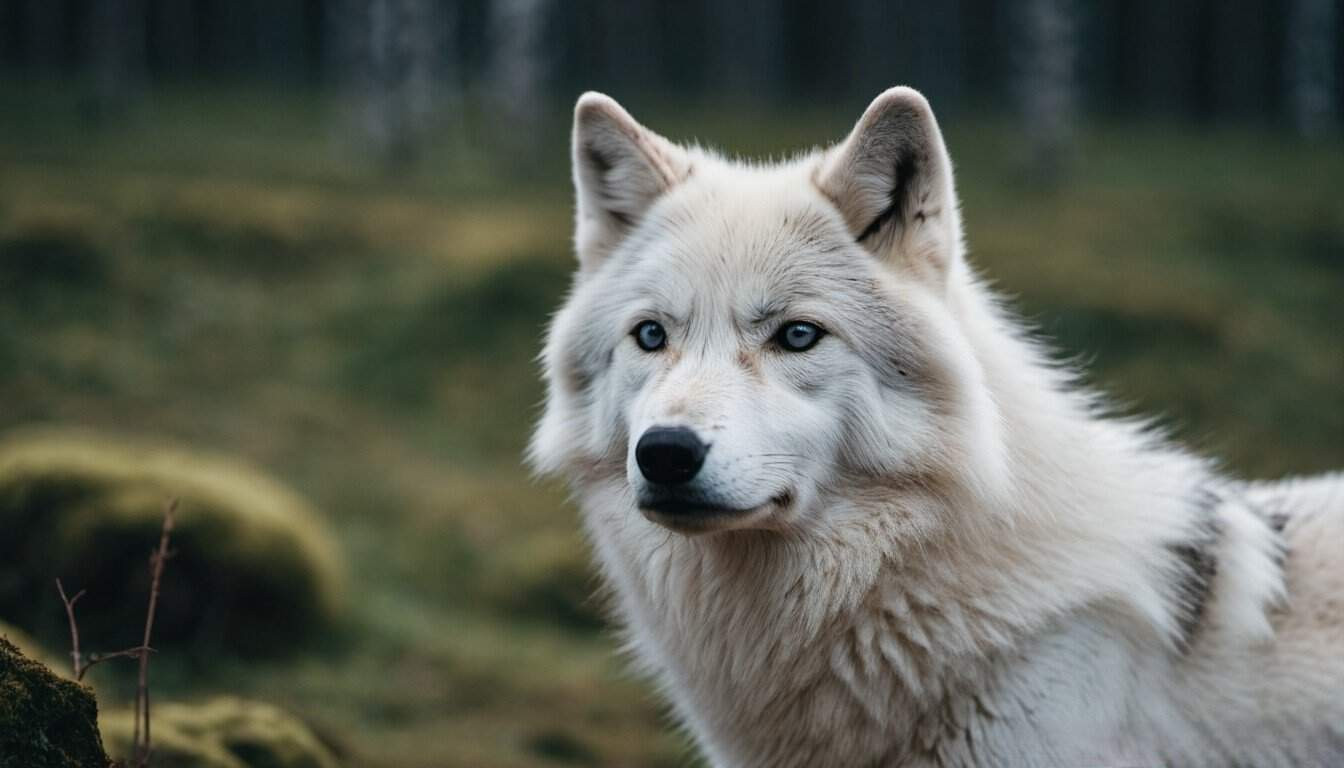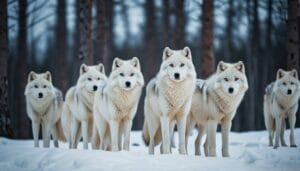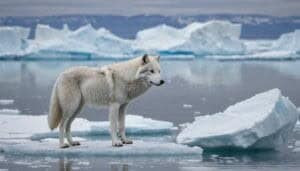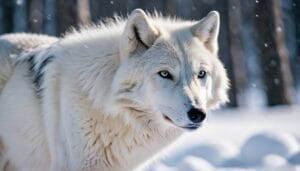Introduction
The diet of the Arctic wolf shifts with the changing seasons, reflecting its adaptability to the harsh environment of the Arctic tundra. Throughout the year, these wolves face varying availability of prey, compelling them to modify their hunting strategies and dietary habits
This article delves into the seasonal changes in the Arctic wolf’s diet, the challenges they face in finding food, and their crucial role in the ecosystem
Seasonal Changes in the Arctic Wolf’s Diet
The Arctic wolf, a subspecies of the gray wolf, has adapted to survive in the extreme conditions of the Arctic tundra. Their diet varies significantly throughout the year, influenced by seasonal changes in prey availability and environmental conditions
Winter Prey and Hunting Strategies
During the harsh Arctic winter, food sources become scarce. The primary prey for Arctic wolves during this time are large mammals, such as caribou and muskoxen
These animals provide a substantial amount of meat, which is crucial for survival when smaller prey are not as accessible. Hunting large prey requires cooperation and strategic planning within the wolf pack. Wolves often hunt in groups, utilizing their strength and numbers to take down these sizeable animals
This pack behavior is essential for overcoming the formidable defenses of caribou and muskoxen, such as their herd formations and powerful kicks
In addition to large mammals, Arctic wolves also hunt smaller animals like Arctic hares and lemmings when available. These smaller prey species are more accessible during winter but do not provide as much sustenance as larger mammals
The scarcity of food in winter forces Arctic wolves to cover large distances in search of prey, sometimes roaming up to several hundred miles
Spring Diet Adjustments
As spring arrives and the snow begins to melt, the Arctic landscape transforms, bringing new life and a shift in the availability of prey. Caribou herds start to migrate, providing a reliable food source for wolves
During this period, the wolves’ diet still predominantly consists of caribou, but they also take advantage of the increased presence of smaller animals, such as Arctic hares and birds. The thawing landscape makes it easier for wolves to hunt smaller prey, which are more active and visible during the spring months
Spring also marks the beginning of the breeding season for many Arctic animals, including birds and smaller mammals. This increase in animal activity provides additional food sources for Arctic wolves, who may raid nests for eggs or young birds
The abundance of these smaller prey items helps supplement the wolves’ diet, allowing them to maintain their energy levels after the harsh winter
Summer Feeding Habits
Summer in the Arctic brings the greatest abundance of food for Arctic wolves. The thawed tundra is teeming with life, and the wolves take full advantage of this period of plenty
Caribou and muskoxen are still major components of their diet, but the presence of other prey increases significantly. Arctic hares, lemmings, birds, and fish become more accessible and frequently hunted during the summer months
During summer, Arctic wolves also consume more vegetation, such as berries and other plant material. This dietary shift helps them make the most of the abundant resources available. The presence of pups in the pack during summer also influences hunting behaviors, as adults need to provide food for the growing young
This period of abundance allows pups to grow rapidly, preparing them for the coming winter
Fall Food Sources
As summer fades into fall, the Arctic landscape begins to prepare for the return of winter. Prey animals like caribou and muskoxen start their migrations, and the availability of smaller animals begins to decrease
During this transitional period, Arctic wolves adjust their diet once again, focusing on fattening up for the winter ahead
Fall is a crucial time for Arctic wolves to build up their fat reserves, which will sustain them during the leaner months of winter. The wolves continue to hunt large mammals but also intensify their efforts to catch smaller prey. They may also scavenge more during this time, taking advantage of any available food sources to maximize their caloric intake
Challenges and Adaptations in Finding Food
Arctic wolves face numerous challenges in securing food throughout the year. Their ability to adapt to these challenges is crucial for their survival in the harsh Arctic environment
Winter Scarcity and Adaptations
Winter poses the most significant challenge for Arctic wolves. The extreme cold and deep snow make hunting difficult, and prey animals are less active and harder to find. To cope with these conditions, Arctic wolves have developed several adaptations:
Pack Hunting: Wolves hunt in packs, which allows them to take down larger prey like caribou and muskoxen that they wouldn’t be able to handle alone. This cooperative behavior increases their chances of a successful hunt
Traveling Long Distances: Arctic wolves have large territories and can travel extensive distances, up to several hundred miles, in search of food. This ability to cover vast areas increases their likelihood of finding prey during the scarce winter months
Efficient Digestion: Wolves have a highly efficient digestive system that allows them to extract maximum nutrients from their food. This efficiency is crucial during times when food is not abundant
Fat Reserves: During the fall, Arctic wolves build up their fat reserves by eating more and storing energy. These fat reserves help sustain them through the winter when food is harder to find
Summer Abundance and Competition
Summer offers a respite from the harshness of winter, but it comes with its own set of challenges. The increase in prey availability also means an increase in competition from other predators. Arctic wolves must adapt their hunting strategies to remain successful:
Diverse Diet: In summer, wolves expand their diet to include a wider range of prey, such as Arctic hares, lemmings, birds, and fish. This dietary flexibility helps them take advantage of the seasonal abundance
Increased Activity: Wolves are more active in summer, taking advantage of the longer daylight hours to hunt and forage. This increased activity level helps them meet the energy demands of raising pups
Territorial Defense: With more food available, wolves must defend their territories from other packs and predators. Territorial behavior ensures that they have access to sufficient food resources for their pack
Cooperative Hunting: Wolves continue to hunt cooperatively, particularly when targeting large prey like caribou. This cooperation maximizes their hunting success and ensures that they can feed their growing pups
Impact of Climate Change on Prey Availability
Climate change is altering the Arctic environment, affecting the availability and distribution of prey species. These changes pose new challenges for Arctic wolves:
Shifting Prey Populations: As temperatures rise, the distribution of prey species like caribou and lemmings is changing. Wolves must adapt to these shifts, which may require traveling even greater distances to find food
Altered Migration Patterns: Changes in climate can affect the migration patterns of prey animals, disrupting the traditional hunting cycles of wolves. This can lead to periods of food scarcity if wolves are not able to adapt quickly
Habitat Changes: Thawing permafrost and changing vegetation patterns can impact the habitats of both wolves and their prey. Wolves must navigate these changing landscapes to locate and hunt their prey
Increased Competition: As the Arctic warms, new predators and competitors may move into the region, increasing competition for food resources. Wolves must contend with these new rivals to secure enough food for their packs
Arctic wolves demonstrate remarkable adaptability in the face of these challenges. Their ability to modify hunting strategies, travel long distances, and cooperate within their packs allows them to survive in one of the most extreme environments on Earth
Role of Arctic Wolves in the Ecosystem
Arctic wolves play a crucial role in maintaining the balance of their ecosystem. As apex predators, they influence the population dynamics of their prey and contribute to the overall health of the Arctic environment
Predator-Prey Relationships
Arctic wolves primarily prey on large herbivores like caribou and muskoxen, as well as smaller animals such as Arctic hares and lemmings
These predator-prey relationships are essential for regulating the populations of these species. By controlling the numbers of herbivores, wolves prevent overgrazing, which can lead to vegetation depletion and habitat degradation:
Regulating Herbivore Populations: By preying on caribou and muskoxen, Arctic wolves help maintain the balance between these herbivores and the vegetation they consume. This regulation ensures that plant communities are not overgrazed, which is vital for the overall health of the tundra ecosystem
Selective Predation: Wolves tend to target the weakest and most vulnerable individuals in a herd, such as the old, sick, or young. This selective predation helps maintain the genetic health of prey populations by removing individuals that are less fit
Impact on Smaller Prey: By preying on smaller animals like hares and lemmings, wolves also influence the populations of these species. This predation helps prevent population explosions that could otherwise lead to habitat degradation and increased competition for resources among small mammals
Effects on Prey Populations
The presence of Arctic wolves has significant effects on the behavior and population dynamics of their prey. These effects extend beyond direct predation and include influencing the distribution and behavior of prey species:
Behavioral Changes: The threat of predation by wolves can cause prey species to alter their behavior. For example, caribou may change their migration routes or grazing patterns to avoid areas with high wolf activity. These behavioral changes can help distribute grazing pressure more evenly across the landscape
Population Cycles: The predation pressure exerted by wolves can lead to population cycles in prey species. For instance, the populations of lemmings and Arctic hares may fluctuate in response to changes in wolf predation rates. These cycles are a natural part of the ecosystem’s dynamics and contribute to its overall stability
Nutrient Redistribution: Wolves contribute to nutrient cycling in the tundra by leaving behind carcasses of their prey. These carcasses provide food for scavengers and decomposers, which in turn release nutrients back into the soil. This nutrient redistribution supports plant growth and overall ecosystem productivity
Ecosystem Balance Throughout the Year
Arctic wolves are integral to the year-round balance of their ecosystem. Their predatory activities and interactions with other species contribute to the dynamic equilibrium of the Arctic tundra:
Winter Dynamics: During the winter, when food is scarce, the impact of wolves on prey populations is more pronounced. By controlling the numbers of caribou and muskoxen, wolves help ensure that the limited vegetation is not overgrazed, which is crucial for the survival of both predator and prey
Spring and Summer Abundance: In the warmer months, the increased availability of prey allows wolf populations to thrive and raise their young. The presence of wolf pups during these months requires adults to hunt more frequently, thereby maintaining their role in regulating prey populations and contributing to the ecosystem’s balance
Fall Preparations: As fall approaches, wolves intensify their hunting efforts to build up fat reserves for the coming winter. This period of increased predation helps prepare the ecosystem for the leaner months ahead, ensuring that prey populations are kept in check and vegetation is preserved
Arctic wolves are not just top predators but key players in their ecosystem. Their interactions with prey species and their role in nutrient cycling highlight their importance in maintaining the health and balance of the Arctic tundra throughout the year
Conclusion
The Arctic wolf, an apex predator of the tundra, exhibits remarkable adaptability in its diet and hunting strategies to survive the extreme conditions of its environment. Throughout the year, the Arctic wolf’s diet shifts in response to the availability of prey and seasonal changes
In winter, they primarily hunt large mammals like caribou and muskoxen, using pack strategies to overcome the scarcity of food. Spring brings a wider variety of prey, including smaller mammals and birds, as the landscape thaws. Summer offers an abundance of food, allowing wolves to hunt a diverse range of animals and even consume vegetation. Fall is a time of preparation, with wolves focusing on building fat reserves for the winter
These seasonal changes in diet are crucial for the survival of Arctic wolves, and they have developed various adaptations to cope with the challenges of finding food. Their role in the ecosystem is equally significant
By regulating prey populations and influencing prey behavior, wolves help maintain the balance of the Arctic tundra. Their predatory activities contribute to nutrient cycling, supporting the overall health and productivity of the environment
Arctic wolves face additional challenges due to climate change, which is altering the availability and distribution of prey species. Despite these challenges, their adaptability and cooperative behaviors ensure they continue to play a vital role in their ecosystem
The dynamic interactions between Arctic wolves and their prey illustrate the complexity and resilience of life in the Arctic, underscoring the importance of preserving this delicate balance in the face of environmental changes











